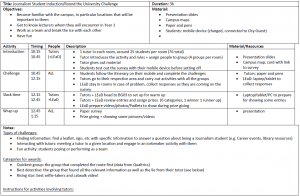As an educational technologist, one of my favourite challenges is to re-purpose technology to fit teaching and learning needs. The best example of this to date for me is using Qualtrics, branded as “Research, Survey and Experience Software” to create a treasure hunt-style induction game for first year undergraduate students!
Contents
Context
The Round the University Challenge is City’s department of Journalism four-in-one student induction activity. It was designed for students to:
- Become familiar with locations that will become important to them
- Get to know Lecturers whom they will encounter in Year 1
- Work as a team and break the ice with each other
- Have fun!
Details of the activity can be found in the post from last year’s iteration.
What was done this year
This year the team focused their effort on building on from the successful activity by designing the routes and challenges entirely online using a single tool. This was intended to make it easier for the students to find locations, receive instructions and upload their photos and videos seamlessly using their mobile device and a web browser. It would also make it easier for the Educational Technology Team to follow the groups’ progression live and access their uploads in one place.
Screenshot of one of the challenges. You can access the whole activity here: bit.ly/roundtheuniversity1
We also involved the lecturers physically rather than virtually in some of the challenges so that students could interact with them face-to-face in an informal setting. Other types of challenges included finding information or doing something fun.
A wrap up activity was also added at the end of the slot for an “award ceremony”
Details of this year’s iteration can be found in the Activity Plan below:
Qualtrics for Treasure Hunts?
As mentioned, one of the focus for this year was to streamline the experience for both students and us educational technologists by limiting the number of tools and resources necessary to carry out the activity or access students’ video and photo submissions.
The idea was for students to use their own device, connected to the guest wifi, to
- Follow their given itinerary to each space;
- Receive instructions for the activity to be carried out in the space; and
- To upload their photo or video evidence for tutors to review when awarding prizes..
…ideally all in one place, not requiring an app or sign in
After some research online to find inspiration for digital scavenger hunts, a post from EdTechTeam member Ronen Cohen on the educational benefits of scavenger hunts and using Google forms to support their digital application ignited the idea to use Qualtrics.
Why survey forms?
Survey tools such as Google forms (used by Ronen) have features that address the needs of a scavenger hunt:
- Linking a place to a challenge: forms can be divided into sections, one for each place and challenge. A section can contain textual information and multimedia, e.g. a map and picture of the place and written instructions below
- Creating an itinerary: sections can be ordered and reordered if several routes need to be created. The form can be set to either require data validation (I.e. entering a response, uploading a file, choosing the correct answer, etc) before being able to move on to the next space/challenge or include interactive controls to let students move on to the next section themselves.
- Providing proof of completion for each task: form responses can be set to file upload to enable students to attach a picture or video of the outcome of their challenge.
Why Qualtrics?
Because City subscribes to it! While Google Form is probably more intuitive to use, it doesn’t offer as many features, and more importantly, it is not compliant with GDPR and requires users to sign in with a Google account when file upload is set for answers, with files being stored on users’ Google Drive. City has an agreement with Qualtrics with regards to processing, accessing and storing personal data and access to the survey can be set in a way that doesn’t require to sign in or identify yourself.
Qualtrics also offers many features to allow users to customise forms to their specific needs: using sections, setting up branching and conditions, rdata validation, personalised themes/feedback, messages etc.
Feedback from students
We asked the students to fill in a minute paper survey during the wrap up and below is a word cloud of the adjectives that they used the most to describe the activity:
Data from the survey, along with feedback form the tutors and Educational Technology Team colleagues will be used to inform next year’s occurrence. Watch this space!





